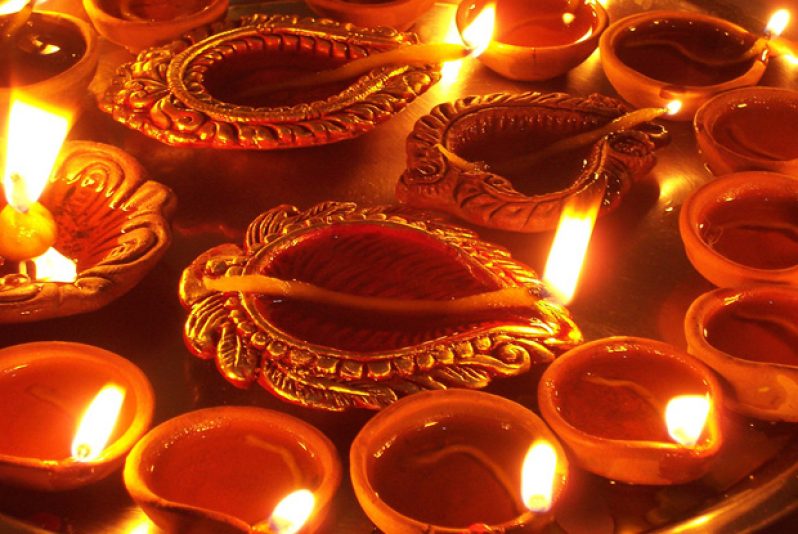HINDUS all over the world celebrate Diwali, and help make this festival grand.
One must be wondering as to why this festival is given such preference over the rest of other Hindu festivals? Well, the reason being for the festival of Diwali is considered as the one that signifies the victory of good over the evil.
Thus, in order to celebrate this festival, many kinds of jubilations and feasts take place all around the world.
The Hindu community in Guyana, Fiji, Mauritius, Myanmar, Malaysia, Nepal, Japan, Thailand, Sri Lanka, Trinidad and Tobago as well as Britain, Indonesia, Singapore, Africa, Australia and even Southern America are known to celebrate Diwali thus they leave no stone unturned to celebrate this festival at its utmost.
In India
In India, the festival of Diwali is celebrated over five days. The celebration in India mainly comprises of displaying of multi-coloured Rangoli designs at the entranceway of residents; arranging for special puja ceremonies; decorating houses with colourful and sparkling lights and earthen lamps (diyas); the exchange of sweets and gifts; fireworks; and lots of shopping.
Every home in the country thus shines with the glow of dazzling lights, and candles that are lit to welcome Goddess Lakshmi on the auspicious occasion.
In the UK
The celebration observed is no less in vigor than seen in India, for the people in Britain make sure they clean themselves as well their homes, so as to provide a feeling of piousness and austerity. People out there wear new clothes, and decorate their homes with fancy decorative lights to celebrate the occasion. The British city of Leicester is, however, notably famous for its Diwali extravaganza.
The official switch-on ceremony is the highlight of Diwali celebrations in Leicester. Thousands of people gather in order to witness the ceremony.
In the USA
However, Diwali celebrations in the USA are quite similar to that witnessed in India, for in the USA, houses are decorated with earthen lamps just like that of their Indian counterparts.
Spectacular displays of sparkling electronic lights are the highlight of the celebrations. Colourful rangolis are also displayed at the entranceway of every household. People in the USA make sure that by evening-time, they gather at the community hall nearby where various cultural events are organized.
Along with the events various fire crackers are burst and Diwali sweets and snacks are distributed among the gathered members. Exchanging of gifts also prove as a dominant ritual.
‘Down Under’
Australia has an estimated population of 100,000 Indians settled there, with the majority of them being Hindus. Thus, it is quite evident that the festival of Diwali will be quite a major event in the country, with large-scale festivities like carnivals and fairs organized in cities such as Sydney and Melbourne.
The events that are mainly featured are fireworks display; food stalls offering Diwali sweetmeats and delicacies; musical performances; and also the burning of the effigy of Ravana.
New Zealand
Auckland and Wellington see the maximum funfair of Diwali celebrations in New Zealand, as the Asia New Zealand Foundation oversees it. These places also have the maximum concentration of Hindus.
Celebrations are always on the weekends following the event. The programmes are marked with Indian performers and artistes flown in from India, and performances ranging from sand sculptures, to classical dances, to puppet shows.
Mauritius
As per census, about 63% of the population in Mauritius has Indian origins, 80% of which are Hindus. Therefore, the celebration of Hindu festivals is a common sight in the land of Mauritius, with the festival of Diwali serving as the premiere of them.
Much like in India, earthen lamps are lit in rows in Mauritius. Goddess Lakshmi is worshipped, and crackers are burst to ward off the evil spirits.
Diwali in Nepal
The festival of Diwali is known as ‘Tihar’ in Nepal, and is thus celebrated for five days, in the month of either October or November.
On the first day of the celebrations, cows are worshipped and given offerings. On the second day, dogs are revered and offered special food. The third day of celebration of Diwali in Nepal is quite similar to that in India, for the festival is celebrated with lights, lamps and social activities.
On the fourth day of celebration, Yama, the Lord of Death, is worshipped and appeased. Whereas on the fifth and final day of the celebration, brothers and sisters meet and exchange gifts.
Thus the customs and traditions observed in Nepal are quite dissimilar with that of India.
Malaysia
Despite having only about 8% of its population belonging to the Hindu community, Diwali still serves as an important festival in Malaysia. The community celebrates the festival as a symbol of triumph of good over evil.
Known as Hari Diwali, it is a public holiday in the country. The traditional ritual of oil bath begins the festival, which includes prayers at household altars, and visits to temples.
Temples here are adorned with flowers and oil lamps, while parades and concerts are organized in some of the major cities. The use of firecrackers, however, is strictly forbidden.
In Indonesia
The name Indonesia is derived from two Greek words: ‘Indos’, meaning Indian, and ‘Nesos’, meaning islands. Thus, it has well-knitted connections with India. Though the majority of Indonesia’s population follows Islam, Hindus constitute about 2% of Indonesia’s total population.
However, that does not mean that the land lags behind in the celebration of Diwali, for it is celebrated with much pomp and gaiety. The island of Bali is mainly famous for the celebrations of Diwali, as the majority of the Indians are concentrated there.
They celebrate the festival by following rituals that are native to India. The celebrations in the country are hence similar to that of India.



.jpg)









